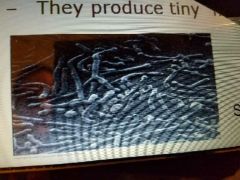![]()
![]()
![]()
Use LEFT and RIGHT arrow keys to navigate between flashcards;
Use UP and DOWN arrow keys to flip the card;
H to show hint;
A reads text to speech;
36 Cards in this Set
- Front
- Back
- 3rd side (hint)
|
Obligate aerobes |
Require 20-21 % of O2 |
|
|
|
Microaerophiloc aerobes |
Require 02 but less than 21% |
|
|
|
Fascultative anerobes |
Can liv and grow with orwithout molecule oxygen,between 0-21% |
|
|
|
Aerotolerant anerobes |
Don't require 02,grow better without 02 ,but can survive in areas with 02 |
|
|
|
Obligate anaerobes |
Cannot survive in 02 environments |
|
|
|
Capnophilic organisms |
Grow best in the presence of increase concentration of C02 (5-10%) |
|
|
|
Fastidious |
Fussy |
Org with especially demanding nutritional require are to be fastidious |
|
|
Nutritional needs |
Of a particular organism are usually char. For that species and arw Sometimes important clues to its identity |
|
|
|
Staphylococci & streptococci can be identified by? |
Enzymes they secrete |
|
|
|
What happens when bacteria grow |
They produce WASTE PRODUCTS AND SECRETIONS SOME are enzymes |
|
|
|
Carbon dioxide or hydrogen sulfide |
Typed of gases produced by bacteria |
|
|
|
How pathogen cause disease |
They pissed capsules,pills, or exdotoxins, or because they secrete exotoxins and exoenzymes that damage cells and tissues |
|
|
|
Typed of pathogenic bacteria |
Niesseria meningitidis, salmonella typhi,shigella app. , vibrio cholera, persona pests, treponema pallidum |
|
|
|
Endotoxins |
Poison remains writing the infected cell until it disintegrates---- may cause typhoid fever and bacillary dysentry |
|
|
|
Exotoxins |
Poison is excreted by the cel into the surrounding area ---- may cause tetanus , gas gangrene,diphtheria, and scarlet fever |
|
|
|
Resistant bacteria |
when bacteria tested against a antibiotics and the antibiotics dont kill it its resistant |
|
|
|
SUSCEPTIBLE |
When bacteria is killed by antibiotics |
|
|
|
Rickettsias & chlamydia |
Have fram positive type of cell Wall and are OBLIGATED INTRACELLULAR PATHOGENS (MUST LIVE WITHIN HOST CELL) |
|
|
|
Rickettsias |
Do not grow on artificial culture media, they have "leaky membranes" Gram-neg cell wall |
|
|
|
Chlamydias |
Are "energy patasites" meaning they prefer to use atp molecule produced by their host cell |
|
|
|
Rickettsia prowazekii cause? |
Epidemic louseborne typhus |
|
|
|
Mycoplasmas |

-Smallest cellular microbes - Lack cell wall so they assumes many shapes.(pleomorphic) - human pathogenic Mycoplasma cause primary atypical pneumonia and genitourinary infections -- Are resistant to drugs like penicillin that attack cell wall cause they have no cell wall -- They produce tiny "fried egg" colonies one artificial media |
|
|
|
Phleomorphic |
Assume many shape |
|
|
|
CHLAMYDIA |
- energy parasite that uses ago as host -gram neg cell wall -obligate INTRACELLULAR pathogen - can cause pneumonia, inclusion conjunctivis, trachoma (blindness) as well as sexual transmission infection |
|
|
|
Virions |
Complete virus particles |
|
|
|
Viruses |
-most are called virions -10-300 nm in diameter -infect humans,animals,plants,fungi,protozoa -some are called oncogenic virus, or oncovirus that cause cancer |
|
|
|
Oncogenic virus/oncoviruses |
Virus that cause specific types of cancer |
Viruses |
|
|
Typical virus consist of? |
Genome of either Dna or dn surrounded by a capsid (protein coat) |
|
|
|
Capsid |
Protein coat which is composed of proteins units called capsomeres |
|
|
|
Envelopes virus |
Have am outer enveloped composed of lipids and polysaccharides |
|
|
|
Virus 5 properties |
1. They possess either Dna or rna (living cell possess both) 2. They are una le to replicate one their own 3. unlike cells, they did not divide by binary fission, mitosis,or moises 4. They lack gene and enzymes necessary for energy production 5. They depend on the ribosomes, enzymes, amd metabolites of the host cell proteins and nucleic acid production |
|
|
|
Viruses are classified by |
1.dna and rna (genetic material) 2. Shape and size 3. number of capsomeres 4.presence or absence of any envelope 5. type of host infects 6. Disease it produces 7 target cell 8.immunologic |
|
|
|
Bacteriiphages |
Virus that infect bacteria are known as bacteriophages or simple, phages |
|
|
|
Virulent bacteriophages |
Always cause what known as lytic cycle, which ends with b the destruction of the bacterial cell |
|
|
|
Temperate (lysogenic) bacteriophages |
Do not use the Lytic cycle but the DNA intergrates into the bacterial chromosomes |
|
|
|
Step to multi viruses |
Attachment Penetration Biosynthesis Assembly Release |
|

